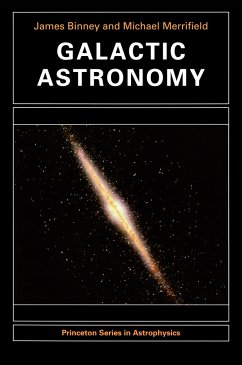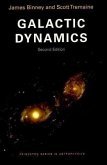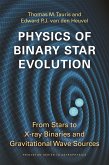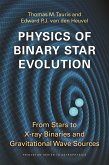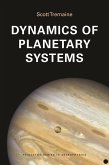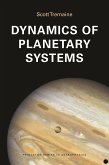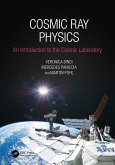- Broschiertes Buch
- Merkliste
- Auf die Merkliste
- Bewerten Bewerten
- Teilen
- Produkt teilen
- Produkterinnerung
- Produkterinnerung
Covers the phenomenology of external galaxies, star clusters in the Milky Way, the interstellar media of external galaxies, gas in the Milky Way, the structure and kinematics of the stellar components of the Milky Way, and the kinematics of external galaxies. This book is intended for professionals, as well as for students.
Andere Kunden interessierten sich auch für
![Galactic Dynamics Galactic Dynamics]() James BinneyGalactic Dynamics118,99 €
James BinneyGalactic Dynamics118,99 €![Physics of Binary Star Evolution Physics of Binary Star Evolution]() Thomas M. TaurisPhysics of Binary Star Evolution84,99 €
Thomas M. TaurisPhysics of Binary Star Evolution84,99 €![Physics of Binary Star Evolution Physics of Binary Star Evolution]() Thomas M. TaurisPhysics of Binary Star Evolution168,99 €
Thomas M. TaurisPhysics of Binary Star Evolution168,99 €![Dynamics of Planetary Systems Dynamics of Planetary Systems]() Scott TremaineDynamics of Planetary Systems65,99 €
Scott TremaineDynamics of Planetary Systems65,99 €![Dynamics of Planetary Systems Dynamics of Planetary Systems]() Scott TremaineDynamics of Planetary Systems157,99 €
Scott TremaineDynamics of Planetary Systems157,99 €![Galaxies Galaxies]() John Gribbin (University of Sussex Visiting Fellow in Astronomy)Galaxies17,99 €
John Gribbin (University of Sussex Visiting Fellow in Astronomy)Galaxies17,99 €![Cosmic Ray Physics Cosmic Ray Physics]() Veronica BindiCosmic Ray Physics170,99 €
Veronica BindiCosmic Ray Physics170,99 €-
-
-
Covers the phenomenology of external galaxies, star clusters in the Milky Way, the interstellar media of external galaxies, gas in the Milky Way, the structure and kinematics of the stellar components of the Milky Way, and the kinematics of external galaxies. This book is intended for professionals, as well as for students.
Hinweis: Dieser Artikel kann nur an eine deutsche Lieferadresse ausgeliefert werden.
Hinweis: Dieser Artikel kann nur an eine deutsche Lieferadresse ausgeliefert werden.
Produktdetails
- Produktdetails
- Princeton Series in Astrophysics
- Verlag: Princeton University Press
- 1998.
- Seitenzahl: 816
- Erscheinungstermin: 6. September 1998
- Englisch
- Abmessung: 235mm x 156mm x 45mm
- Gewicht: 1202g
- ISBN-13: 9780691025650
- ISBN-10: 0691025657
- Artikelnr.: 09578644
- Herstellerkennzeichnung
- Libri GmbH
- Europaallee 1
- 36244 Bad Hersfeld
- gpsr@libri.de
- Princeton Series in Astrophysics
- Verlag: Princeton University Press
- 1998.
- Seitenzahl: 816
- Erscheinungstermin: 6. September 1998
- Englisch
- Abmessung: 235mm x 156mm x 45mm
- Gewicht: 1202g
- ISBN-13: 9780691025650
- ISBN-10: 0691025657
- Artikelnr.: 09578644
- Herstellerkennzeichnung
- Libri GmbH
- Europaallee 1
- 36244 Bad Hersfeld
- gpsr@libri.de
James Binney & Michael Merrifield
Preface
1 Galaxies: an overview 1.1 Introduction 1 1.2 A brief history of galactic
astronomy 2 Photometric models of the Milky Way 5 The nature of the spiral
nebulae 10 Kinematic models of the Milky Way 15 Stellar populations 20 More
recent developments 21
2 Astronomical Measurements 2.1 Positions, motions and coordinate systems
27 The equatorial system 27 Galactic coordinates 30 Parallax 31 Proper
motions 34 Precession and nutation 35 Astrometric systems 37 2.2 Distances
determined from velocities 38 Radial velocities 39 Distances from the
movingcluster method 40 Secular parallaxes 42 Statistical parallaxes 45 2.3
Magnitudes and colors 46 Apparent magnitudes 47 Colors 52 Absolute
magnitudes 56 Absolute energy distributions and bolometric magnitudes 58
Mass-to-light ratios 60 Surface brightness and isophotal radii 61 2.4
Gravitational lensing 62 2.5 Archival data and catalogs 67 On-line
resources 71 Problems 74
3 The Properties of Stars 3.1 The masses of stars 76 The Mass of the Sun 77
Masses of binary stars 78 Visual binaries 78 Spectroscopic binaries 79 3.2
The radii of stars 82 Phase interferometry 82 Intensity interferometry 83
Speckle interferometry 83 Lunar occultations 84 Eclipsing binaries 84
Astrophysical estimates 86 3.3 Classification of stars 87 Novae 87 Pulsars
87 Classification of stellar spectra 88 The MK system 90 3.4 Physical
interpretation of stellar spectra 94 3.5 Color-magnitude diagrams 102
Observed CM-diagrams 103 Luminosity and color as functions of spectral
class 104 The physical properties of stars on the MS and RGB 109 3.6 The
stellar luminosity function 109 Malmquist bias 111 Lutz-Kelker Bias 115 The
general luminosity function 119 Cluster luminosity functions 119
Photometrically complete surveys 119 Proper-motion selected surveys 120 The
luminosity function of a given MK spectral class 127 Catalogs of the nearby
stars 130 3.7 Interstellar dust 131 Extinction and reddening 133
Reddening-free indices 138 Polarization of starlight by dust 140 Extinction
of sightlines out of the Galaxy 140 Problems 143
4 Morphology of Galaxies 4.1 Morphological classification of galaxies 146
The Hubble sequence 149 Effects of environment 157 The galaxy luminosity
function 162 The field galaxy luminosity function 162 The cluster galaxy
luminosity function 165 The luminosity function divided by morphological
type 167 The Local Group 169 4.2 Surface Photometry of Galaxies 172 The
night sky 173 Effect of seeing 176 Deprojecting galaxy images 179 4.3
Photometry of Elliptical Galaxies 185 Radial surface-brightness profiles of
elliptical galaxies 185 cD galaxies 186 Dwarf elliptical galaxies 190
Centers of elliptical galaxies 191 Color and line-strength gradients in
elliptical galaxies 193 Shapes of elliptical galaxies 194 Ellipticity 194
Deviations from ellipses 199 Fine structure 201 Correlations among global
parameters of elliptical galaxies 204 The Dn - [Sigma]<0 correlation 209
Dwarf elliptical galaxies 209 4.4 Photometry of Disk Galaxies 210
Photometric effects of dust 211 Overall shapes of disk galaxies 212
Bulge-disk decomposition 214 Shapes of bulges 222 Color and metallicity
gradients in disk galaxies 223 Spiral structure in disk galaxies 224 Barred
galaxies 228 Vertical structure of bars 231 Rings in SB galaxies 233 Dust
lanes in SB galaxies 234 Lop-sidedness in SB galaxies 234 4.5 Globular
cluster systems 235 Globular cluster luminosity function 236 Specific
frequency of globular clusters 237 Radial density profiles and shapes 238
Color distributions 239 4.6 Abnormal galaxies 241 Starbursting systems 241
Systems with active galactic nuclei 244 Host galaxies of AGN 250 The
unified model of AGN 251 Problems 255
5 Evolution of Stars and Stellar Populations 5.1 Stellar evolution and the
CM diagram 259 Placing models in the CM diagram 262 Features in the CM
diagram 263 Characteristic initial masses 267 Bounding curves in the CM
diagram 274 Dependence of CM diagrams upon metallicity 276 The cosmic
helium abundance 279 Simple numerical relations 279 Star formation 281 The
initial mass function 283 Pulsating stars 287 Classical Cepheid variables
289 Mira variables 292 W Virginis stars 293 RR Lyrae stars 293 5.2
Synthesis of the chemical elements 296 Basic nuclear physics 296 Metal
production at Mi < Mup 301 Supernovae 302 Metal production by core-collapse
supernovae 303 Metal production by type Ia supernovae 305 5.3 Models of
chemical enrichment 306 The closed-box model 306 The leaky-box model 308
The accreting-box model 313 5.4 Evolution of stellar populations 314
Analytical results 315 Numerical models of population evolution 317
Problems 324
6 Star clusters 6.1 Globular clusters 327 Globular cluster stellar
photometry 332 Color-magnitude diagrams 334 The main sequence and subgiant
branch 335 The horizontal branch 337 Comparison with Theoretical CM
diagrams 339 Globular cluster ages 344 Turnoff point ages 344 Isochrone
fitting 345 The [Delta]
clusters 350 [Omega] Cen 351 The third parameter problem 352 Variations in
helium abundance 353 Variations in other element abundances 353 Other
candidates 354 Luminosity functions 354 Binary stars 359 Stellar remnants
361 White dwarfs 361 Neutron stars 362 Radial profiles 363 Large-scale
properties 365 Luminosity segregation 367 Central cusps 369 Kinematics 371
Velocities of individual stars 371 Integrated-light kinematics 374 Proper
motions 375 6.2 Open clusters 377 Color-magnitude diagrams 381 The ages and
demise of open clusters 384 Structure and kinematics 386 Luminosity
function 389 Problems 392
7 The Cosmic Distance Scale 7.1 An introduction to cosmology 396 7.2
Absolute distance estimators 399 The Baade-Wesselink method 399 Application
to supernovae 402 The Sunyaev-Zel'dovich effect 403 Distances from time
delays 405 The ring around Supernova 1987A 406 Gravitational lens time
delays 407 Water-maser proper-motions by VLBI 410 7.3 Relative distance
estimators 414 Luminosities of variable stars 415 Luminosity functions 415
Globular clusters 416 Planetary nebulae 417 Novae and supernovae 419 Novae
419 Type Ia supernovae 420 Distances from galaxy kinematics 422 Spiral
galaxies 422 Elliptical galaxies 425 Surface brightness fluctuations 426
7.4 Results 429 Distances within the Local Group 432 Distance to the
Galactic center 432 Distance to the Large Magellanic Cloud 434 Distance to
M31 435 Distances beyond the Local Group 437 Distance to the Virgo Cluster
437 Peculiar velocity field 439 The asymptotic Hubble constant 441 The
deceleration parameter and cosmic density 444 Standard candles and rulers
444 Peculiar velocity field 447 Problems 449
8 The Interstellar Media of Galaxies 8.1 How interstellar matter is
detected 452 Absorption of starlight 452 Extreme UV and Xray observations
459 Optical emission lines 463 Hydrogen lines 463 Metal lines 464 Radio
observations 468 The 21-cm line of atomic hydrogen 471 Rotation transitions
of heteronuclear molecules 474 Synchrotron radiation 478 Radio-frequency
bremsstrahlung and recombination lines 480 Dispersion and Rotation Measures
481 Gamma-ray emission 482 Radiation by dust 483 8.2 The ISM in Disk
Galaxies 488 Global measures 493 HI and H2 in disk galaxies 493
Radio-continuum and IR luminosities 496 Radial density profiles 498
Azimuthal distributions 500 Bars and oval distortions 500 Spiral structure
500 Lop-sidedness 502 Velocity fields of disks 505 Circular-speed curves
507 Kinematic warps 510 Oval distortions 512 S0 galaxies 513 Metallicities
of disk galaxies 516 Magnetic fields 520 Star formation in disk galaxies
522 8.3 The ISM in elliptical galaxies 525 X-ray emitting plasma 525 Cool
gas in ellipticals 527 8.4 Intergalactic gas 530 The Magellanic Stream 530
Problems 533
9 The Milky Way's ISM 9.1 The kinematics of differential rotation 536 The
naive (l,v) plot 536 Radii and distances from the (l,v) plot 540
Non-circular motion and the (l,v) plot 541 Axisymmetric expansion 541 Oval
distortions 542 Spiral structure 544 Random motions 546 9.2 The large-scale
distribution of HI and CO 549 The 21-cm line in emission 549 Measuring the
spin temperature 553 CO lines in emission 554 The Milky Way's
circular-speed curve 555 Radial distributions of HI and CO 559 Evidence for
spiral structure 561 Vertical distributions of HI and CO 562 The middle
disk 563 The outer disk 565 9.3 Other tracers of the ISM 570 Diffuse
infrared emission 570 Pulsars and the Galactic magnetic field 574 Diffuse
H[Alpha] radiation 576 Diffuse synchrotron and Gamma-radiation 577 Diffuse
X-rays 579 9.4 The central disk 580 21-cm observations 580 Observations in
lines of CO and CS 586 A dynamical model of the central disk 588 9.5 The
nucleus 594 9.6 Small-scale structure of the ISM 597 Molecular gas in the
Galaxy 598 X from virial masses 601 X from Gamma-rays 601 X from Av 602
Problems 603
10 Components of the Milky Way 10.1 Gross Structure from Surface Photometry
609 The Galaxy at optical wavelengths 614 10.2 The bulge 616 Integrated
surface photometry 616 Evidence for a bar from individual stars 619 Age and
metallicity of the bulge 621 Bulge kinematics 622 10.3 Kinematics of stars
near the Sun 624 The solar motion 624 Random velocities of stars 629 Vertex
deviation 630 The Schwarzschild distribution 632 Star streams 634 Causes of
vertex deviation 636 The Oort constants 637 Estimating the Oort constants
641 10.4 The structure of the stellar disk 643 Ages and metallicities of
nearby stars 643 Correlations between abundances 643 Correlations between
age and abundance 644 The old disk clusters 651 Star counts and the thick
disk 651 The thick disk 654 The local mass density of the disk 656
Distribution of the youngest stars 664 10.5 The halo 666 The globular
cluster system 666 Field halo stars 670 Kinematically selected samples 673
10.6 Galaxy models 678 The local circular speed 679 Mass models 680
Starcount models 682 Kinematic models 683 Dynamical models 683 10.7
Formation and evolution of the Milky Way 684 Formation scenarios 684 Models
of the chemical evolution of the Milky Way 688 Chemical evolution of the
halo 688 Pre-enrichment 688 Problems 690
11 Stellar Kinematics in External Galaxies 11.1 Measuring the kinematics of
external galaxies 694 Mean velocities and velocity dispersions 697 Analysis
of line profiles 700 Position-velocity diagrams and data cubes 705 11.2 The
stellar kinematics of elliptical galaxies 707 Large-scale properties 707
Major-axis kinematics 707 Detection of dark halos 712 Kinematic mapping 713
Core properties 716 Decoupled cores 716 Detection of central black holes
717 11.3 The stellar kinematics of disk galaxies 722 Bulge kinematics 723
Disk kinematics 724 Rotational motion 725 Random motions 727 Problems 730
Appendices A. Gravitational deflection of light 732 B. Important
astronomical catalogs 736 C. Richardson-Lucy deconvolution 743 D. Useful
numbers 744
References Index
1 Galaxies: an overview 1.1 Introduction 1 1.2 A brief history of galactic
astronomy 2 Photometric models of the Milky Way 5 The nature of the spiral
nebulae 10 Kinematic models of the Milky Way 15 Stellar populations 20 More
recent developments 21
2 Astronomical Measurements 2.1 Positions, motions and coordinate systems
27 The equatorial system 27 Galactic coordinates 30 Parallax 31 Proper
motions 34 Precession and nutation 35 Astrometric systems 37 2.2 Distances
determined from velocities 38 Radial velocities 39 Distances from the
movingcluster method 40 Secular parallaxes 42 Statistical parallaxes 45 2.3
Magnitudes and colors 46 Apparent magnitudes 47 Colors 52 Absolute
magnitudes 56 Absolute energy distributions and bolometric magnitudes 58
Mass-to-light ratios 60 Surface brightness and isophotal radii 61 2.4
Gravitational lensing 62 2.5 Archival data and catalogs 67 On-line
resources 71 Problems 74
3 The Properties of Stars 3.1 The masses of stars 76 The Mass of the Sun 77
Masses of binary stars 78 Visual binaries 78 Spectroscopic binaries 79 3.2
The radii of stars 82 Phase interferometry 82 Intensity interferometry 83
Speckle interferometry 83 Lunar occultations 84 Eclipsing binaries 84
Astrophysical estimates 86 3.3 Classification of stars 87 Novae 87 Pulsars
87 Classification of stellar spectra 88 The MK system 90 3.4 Physical
interpretation of stellar spectra 94 3.5 Color-magnitude diagrams 102
Observed CM-diagrams 103 Luminosity and color as functions of spectral
class 104 The physical properties of stars on the MS and RGB 109 3.6 The
stellar luminosity function 109 Malmquist bias 111 Lutz-Kelker Bias 115 The
general luminosity function 119 Cluster luminosity functions 119
Photometrically complete surveys 119 Proper-motion selected surveys 120 The
luminosity function of a given MK spectral class 127 Catalogs of the nearby
stars 130 3.7 Interstellar dust 131 Extinction and reddening 133
Reddening-free indices 138 Polarization of starlight by dust 140 Extinction
of sightlines out of the Galaxy 140 Problems 143
4 Morphology of Galaxies 4.1 Morphological classification of galaxies 146
The Hubble sequence 149 Effects of environment 157 The galaxy luminosity
function 162 The field galaxy luminosity function 162 The cluster galaxy
luminosity function 165 The luminosity function divided by morphological
type 167 The Local Group 169 4.2 Surface Photometry of Galaxies 172 The
night sky 173 Effect of seeing 176 Deprojecting galaxy images 179 4.3
Photometry of Elliptical Galaxies 185 Radial surface-brightness profiles of
elliptical galaxies 185 cD galaxies 186 Dwarf elliptical galaxies 190
Centers of elliptical galaxies 191 Color and line-strength gradients in
elliptical galaxies 193 Shapes of elliptical galaxies 194 Ellipticity 194
Deviations from ellipses 199 Fine structure 201 Correlations among global
parameters of elliptical galaxies 204 The Dn - [Sigma]<0 correlation 209
Dwarf elliptical galaxies 209 4.4 Photometry of Disk Galaxies 210
Photometric effects of dust 211 Overall shapes of disk galaxies 212
Bulge-disk decomposition 214 Shapes of bulges 222 Color and metallicity
gradients in disk galaxies 223 Spiral structure in disk galaxies 224 Barred
galaxies 228 Vertical structure of bars 231 Rings in SB galaxies 233 Dust
lanes in SB galaxies 234 Lop-sidedness in SB galaxies 234 4.5 Globular
cluster systems 235 Globular cluster luminosity function 236 Specific
frequency of globular clusters 237 Radial density profiles and shapes 238
Color distributions 239 4.6 Abnormal galaxies 241 Starbursting systems 241
Systems with active galactic nuclei 244 Host galaxies of AGN 250 The
unified model of AGN 251 Problems 255
5 Evolution of Stars and Stellar Populations 5.1 Stellar evolution and the
CM diagram 259 Placing models in the CM diagram 262 Features in the CM
diagram 263 Characteristic initial masses 267 Bounding curves in the CM
diagram 274 Dependence of CM diagrams upon metallicity 276 The cosmic
helium abundance 279 Simple numerical relations 279 Star formation 281 The
initial mass function 283 Pulsating stars 287 Classical Cepheid variables
289 Mira variables 292 W Virginis stars 293 RR Lyrae stars 293 5.2
Synthesis of the chemical elements 296 Basic nuclear physics 296 Metal
production at Mi < Mup 301 Supernovae 302 Metal production by core-collapse
supernovae 303 Metal production by type Ia supernovae 305 5.3 Models of
chemical enrichment 306 The closed-box model 306 The leaky-box model 308
The accreting-box model 313 5.4 Evolution of stellar populations 314
Analytical results 315 Numerical models of population evolution 317
Problems 324
6 Star clusters 6.1 Globular clusters 327 Globular cluster stellar
photometry 332 Color-magnitude diagrams 334 The main sequence and subgiant
branch 335 The horizontal branch 337 Comparison with Theoretical CM
diagrams 339 Globular cluster ages 344 Turnoff point ages 344 Isochrone
fitting 345 The [Delta]
clusters 350 [Omega] Cen 351 The third parameter problem 352 Variations in
helium abundance 353 Variations in other element abundances 353 Other
candidates 354 Luminosity functions 354 Binary stars 359 Stellar remnants
361 White dwarfs 361 Neutron stars 362 Radial profiles 363 Large-scale
properties 365 Luminosity segregation 367 Central cusps 369 Kinematics 371
Velocities of individual stars 371 Integrated-light kinematics 374 Proper
motions 375 6.2 Open clusters 377 Color-magnitude diagrams 381 The ages and
demise of open clusters 384 Structure and kinematics 386 Luminosity
function 389 Problems 392
7 The Cosmic Distance Scale 7.1 An introduction to cosmology 396 7.2
Absolute distance estimators 399 The Baade-Wesselink method 399 Application
to supernovae 402 The Sunyaev-Zel'dovich effect 403 Distances from time
delays 405 The ring around Supernova 1987A 406 Gravitational lens time
delays 407 Water-maser proper-motions by VLBI 410 7.3 Relative distance
estimators 414 Luminosities of variable stars 415 Luminosity functions 415
Globular clusters 416 Planetary nebulae 417 Novae and supernovae 419 Novae
419 Type Ia supernovae 420 Distances from galaxy kinematics 422 Spiral
galaxies 422 Elliptical galaxies 425 Surface brightness fluctuations 426
7.4 Results 429 Distances within the Local Group 432 Distance to the
Galactic center 432 Distance to the Large Magellanic Cloud 434 Distance to
M31 435 Distances beyond the Local Group 437 Distance to the Virgo Cluster
437 Peculiar velocity field 439 The asymptotic Hubble constant 441 The
deceleration parameter and cosmic density 444 Standard candles and rulers
444 Peculiar velocity field 447 Problems 449
8 The Interstellar Media of Galaxies 8.1 How interstellar matter is
detected 452 Absorption of starlight 452 Extreme UV and Xray observations
459 Optical emission lines 463 Hydrogen lines 463 Metal lines 464 Radio
observations 468 The 21-cm line of atomic hydrogen 471 Rotation transitions
of heteronuclear molecules 474 Synchrotron radiation 478 Radio-frequency
bremsstrahlung and recombination lines 480 Dispersion and Rotation Measures
481 Gamma-ray emission 482 Radiation by dust 483 8.2 The ISM in Disk
Galaxies 488 Global measures 493 HI and H2 in disk galaxies 493
Radio-continuum and IR luminosities 496 Radial density profiles 498
Azimuthal distributions 500 Bars and oval distortions 500 Spiral structure
500 Lop-sidedness 502 Velocity fields of disks 505 Circular-speed curves
507 Kinematic warps 510 Oval distortions 512 S0 galaxies 513 Metallicities
of disk galaxies 516 Magnetic fields 520 Star formation in disk galaxies
522 8.3 The ISM in elliptical galaxies 525 X-ray emitting plasma 525 Cool
gas in ellipticals 527 8.4 Intergalactic gas 530 The Magellanic Stream 530
Problems 533
9 The Milky Way's ISM 9.1 The kinematics of differential rotation 536 The
naive (l,v) plot 536 Radii and distances from the (l,v) plot 540
Non-circular motion and the (l,v) plot 541 Axisymmetric expansion 541 Oval
distortions 542 Spiral structure 544 Random motions 546 9.2 The large-scale
distribution of HI and CO 549 The 21-cm line in emission 549 Measuring the
spin temperature 553 CO lines in emission 554 The Milky Way's
circular-speed curve 555 Radial distributions of HI and CO 559 Evidence for
spiral structure 561 Vertical distributions of HI and CO 562 The middle
disk 563 The outer disk 565 9.3 Other tracers of the ISM 570 Diffuse
infrared emission 570 Pulsars and the Galactic magnetic field 574 Diffuse
H[Alpha] radiation 576 Diffuse synchrotron and Gamma-radiation 577 Diffuse
X-rays 579 9.4 The central disk 580 21-cm observations 580 Observations in
lines of CO and CS 586 A dynamical model of the central disk 588 9.5 The
nucleus 594 9.6 Small-scale structure of the ISM 597 Molecular gas in the
Galaxy 598 X from virial masses 601 X from Gamma-rays 601 X from Av 602
Problems 603
10 Components of the Milky Way 10.1 Gross Structure from Surface Photometry
609 The Galaxy at optical wavelengths 614 10.2 The bulge 616 Integrated
surface photometry 616 Evidence for a bar from individual stars 619 Age and
metallicity of the bulge 621 Bulge kinematics 622 10.3 Kinematics of stars
near the Sun 624 The solar motion 624 Random velocities of stars 629 Vertex
deviation 630 The Schwarzschild distribution 632 Star streams 634 Causes of
vertex deviation 636 The Oort constants 637 Estimating the Oort constants
641 10.4 The structure of the stellar disk 643 Ages and metallicities of
nearby stars 643 Correlations between abundances 643 Correlations between
age and abundance 644 The old disk clusters 651 Star counts and the thick
disk 651 The thick disk 654 The local mass density of the disk 656
Distribution of the youngest stars 664 10.5 The halo 666 The globular
cluster system 666 Field halo stars 670 Kinematically selected samples 673
10.6 Galaxy models 678 The local circular speed 679 Mass models 680
Starcount models 682 Kinematic models 683 Dynamical models 683 10.7
Formation and evolution of the Milky Way 684 Formation scenarios 684 Models
of the chemical evolution of the Milky Way 688 Chemical evolution of the
halo 688 Pre-enrichment 688 Problems 690
11 Stellar Kinematics in External Galaxies 11.1 Measuring the kinematics of
external galaxies 694 Mean velocities and velocity dispersions 697 Analysis
of line profiles 700 Position-velocity diagrams and data cubes 705 11.2 The
stellar kinematics of elliptical galaxies 707 Large-scale properties 707
Major-axis kinematics 707 Detection of dark halos 712 Kinematic mapping 713
Core properties 716 Decoupled cores 716 Detection of central black holes
717 11.3 The stellar kinematics of disk galaxies 722 Bulge kinematics 723
Disk kinematics 724 Rotational motion 725 Random motions 727 Problems 730
Appendices A. Gravitational deflection of light 732 B. Important
astronomical catalogs 736 C. Richardson-Lucy deconvolution 743 D. Useful
numbers 744
References Index
Preface
1 Galaxies: an overview 1.1 Introduction 1 1.2 A brief history of galactic
astronomy 2 Photometric models of the Milky Way 5 The nature of the spiral
nebulae 10 Kinematic models of the Milky Way 15 Stellar populations 20 More
recent developments 21
2 Astronomical Measurements 2.1 Positions, motions and coordinate systems
27 The equatorial system 27 Galactic coordinates 30 Parallax 31 Proper
motions 34 Precession and nutation 35 Astrometric systems 37 2.2 Distances
determined from velocities 38 Radial velocities 39 Distances from the
movingcluster method 40 Secular parallaxes 42 Statistical parallaxes 45 2.3
Magnitudes and colors 46 Apparent magnitudes 47 Colors 52 Absolute
magnitudes 56 Absolute energy distributions and bolometric magnitudes 58
Mass-to-light ratios 60 Surface brightness and isophotal radii 61 2.4
Gravitational lensing 62 2.5 Archival data and catalogs 67 On-line
resources 71 Problems 74
3 The Properties of Stars 3.1 The masses of stars 76 The Mass of the Sun 77
Masses of binary stars 78 Visual binaries 78 Spectroscopic binaries 79 3.2
The radii of stars 82 Phase interferometry 82 Intensity interferometry 83
Speckle interferometry 83 Lunar occultations 84 Eclipsing binaries 84
Astrophysical estimates 86 3.3 Classification of stars 87 Novae 87 Pulsars
87 Classification of stellar spectra 88 The MK system 90 3.4 Physical
interpretation of stellar spectra 94 3.5 Color-magnitude diagrams 102
Observed CM-diagrams 103 Luminosity and color as functions of spectral
class 104 The physical properties of stars on the MS and RGB 109 3.6 The
stellar luminosity function 109 Malmquist bias 111 Lutz-Kelker Bias 115 The
general luminosity function 119 Cluster luminosity functions 119
Photometrically complete surveys 119 Proper-motion selected surveys 120 The
luminosity function of a given MK spectral class 127 Catalogs of the nearby
stars 130 3.7 Interstellar dust 131 Extinction and reddening 133
Reddening-free indices 138 Polarization of starlight by dust 140 Extinction
of sightlines out of the Galaxy 140 Problems 143
4 Morphology of Galaxies 4.1 Morphological classification of galaxies 146
The Hubble sequence 149 Effects of environment 157 The galaxy luminosity
function 162 The field galaxy luminosity function 162 The cluster galaxy
luminosity function 165 The luminosity function divided by morphological
type 167 The Local Group 169 4.2 Surface Photometry of Galaxies 172 The
night sky 173 Effect of seeing 176 Deprojecting galaxy images 179 4.3
Photometry of Elliptical Galaxies 185 Radial surface-brightness profiles of
elliptical galaxies 185 cD galaxies 186 Dwarf elliptical galaxies 190
Centers of elliptical galaxies 191 Color and line-strength gradients in
elliptical galaxies 193 Shapes of elliptical galaxies 194 Ellipticity 194
Deviations from ellipses 199 Fine structure 201 Correlations among global
parameters of elliptical galaxies 204 The Dn - [Sigma]<0 correlation 209
Dwarf elliptical galaxies 209 4.4 Photometry of Disk Galaxies 210
Photometric effects of dust 211 Overall shapes of disk galaxies 212
Bulge-disk decomposition 214 Shapes of bulges 222 Color and metallicity
gradients in disk galaxies 223 Spiral structure in disk galaxies 224 Barred
galaxies 228 Vertical structure of bars 231 Rings in SB galaxies 233 Dust
lanes in SB galaxies 234 Lop-sidedness in SB galaxies 234 4.5 Globular
cluster systems 235 Globular cluster luminosity function 236 Specific
frequency of globular clusters 237 Radial density profiles and shapes 238
Color distributions 239 4.6 Abnormal galaxies 241 Starbursting systems 241
Systems with active galactic nuclei 244 Host galaxies of AGN 250 The
unified model of AGN 251 Problems 255
5 Evolution of Stars and Stellar Populations 5.1 Stellar evolution and the
CM diagram 259 Placing models in the CM diagram 262 Features in the CM
diagram 263 Characteristic initial masses 267 Bounding curves in the CM
diagram 274 Dependence of CM diagrams upon metallicity 276 The cosmic
helium abundance 279 Simple numerical relations 279 Star formation 281 The
initial mass function 283 Pulsating stars 287 Classical Cepheid variables
289 Mira variables 292 W Virginis stars 293 RR Lyrae stars 293 5.2
Synthesis of the chemical elements 296 Basic nuclear physics 296 Metal
production at Mi < Mup 301 Supernovae 302 Metal production by core-collapse
supernovae 303 Metal production by type Ia supernovae 305 5.3 Models of
chemical enrichment 306 The closed-box model 306 The leaky-box model 308
The accreting-box model 313 5.4 Evolution of stellar populations 314
Analytical results 315 Numerical models of population evolution 317
Problems 324
6 Star clusters 6.1 Globular clusters 327 Globular cluster stellar
photometry 332 Color-magnitude diagrams 334 The main sequence and subgiant
branch 335 The horizontal branch 337 Comparison with Theoretical CM
diagrams 339 Globular cluster ages 344 Turnoff point ages 344 Isochrone
fitting 345 The [Delta]
clusters 350 [Omega] Cen 351 The third parameter problem 352 Variations in
helium abundance 353 Variations in other element abundances 353 Other
candidates 354 Luminosity functions 354 Binary stars 359 Stellar remnants
361 White dwarfs 361 Neutron stars 362 Radial profiles 363 Large-scale
properties 365 Luminosity segregation 367 Central cusps 369 Kinematics 371
Velocities of individual stars 371 Integrated-light kinematics 374 Proper
motions 375 6.2 Open clusters 377 Color-magnitude diagrams 381 The ages and
demise of open clusters 384 Structure and kinematics 386 Luminosity
function 389 Problems 392
7 The Cosmic Distance Scale 7.1 An introduction to cosmology 396 7.2
Absolute distance estimators 399 The Baade-Wesselink method 399 Application
to supernovae 402 The Sunyaev-Zel'dovich effect 403 Distances from time
delays 405 The ring around Supernova 1987A 406 Gravitational lens time
delays 407 Water-maser proper-motions by VLBI 410 7.3 Relative distance
estimators 414 Luminosities of variable stars 415 Luminosity functions 415
Globular clusters 416 Planetary nebulae 417 Novae and supernovae 419 Novae
419 Type Ia supernovae 420 Distances from galaxy kinematics 422 Spiral
galaxies 422 Elliptical galaxies 425 Surface brightness fluctuations 426
7.4 Results 429 Distances within the Local Group 432 Distance to the
Galactic center 432 Distance to the Large Magellanic Cloud 434 Distance to
M31 435 Distances beyond the Local Group 437 Distance to the Virgo Cluster
437 Peculiar velocity field 439 The asymptotic Hubble constant 441 The
deceleration parameter and cosmic density 444 Standard candles and rulers
444 Peculiar velocity field 447 Problems 449
8 The Interstellar Media of Galaxies 8.1 How interstellar matter is
detected 452 Absorption of starlight 452 Extreme UV and Xray observations
459 Optical emission lines 463 Hydrogen lines 463 Metal lines 464 Radio
observations 468 The 21-cm line of atomic hydrogen 471 Rotation transitions
of heteronuclear molecules 474 Synchrotron radiation 478 Radio-frequency
bremsstrahlung and recombination lines 480 Dispersion and Rotation Measures
481 Gamma-ray emission 482 Radiation by dust 483 8.2 The ISM in Disk
Galaxies 488 Global measures 493 HI and H2 in disk galaxies 493
Radio-continuum and IR luminosities 496 Radial density profiles 498
Azimuthal distributions 500 Bars and oval distortions 500 Spiral structure
500 Lop-sidedness 502 Velocity fields of disks 505 Circular-speed curves
507 Kinematic warps 510 Oval distortions 512 S0 galaxies 513 Metallicities
of disk galaxies 516 Magnetic fields 520 Star formation in disk galaxies
522 8.3 The ISM in elliptical galaxies 525 X-ray emitting plasma 525 Cool
gas in ellipticals 527 8.4 Intergalactic gas 530 The Magellanic Stream 530
Problems 533
9 The Milky Way's ISM 9.1 The kinematics of differential rotation 536 The
naive (l,v) plot 536 Radii and distances from the (l,v) plot 540
Non-circular motion and the (l,v) plot 541 Axisymmetric expansion 541 Oval
distortions 542 Spiral structure 544 Random motions 546 9.2 The large-scale
distribution of HI and CO 549 The 21-cm line in emission 549 Measuring the
spin temperature 553 CO lines in emission 554 The Milky Way's
circular-speed curve 555 Radial distributions of HI and CO 559 Evidence for
spiral structure 561 Vertical distributions of HI and CO 562 The middle
disk 563 The outer disk 565 9.3 Other tracers of the ISM 570 Diffuse
infrared emission 570 Pulsars and the Galactic magnetic field 574 Diffuse
H[Alpha] radiation 576 Diffuse synchrotron and Gamma-radiation 577 Diffuse
X-rays 579 9.4 The central disk 580 21-cm observations 580 Observations in
lines of CO and CS 586 A dynamical model of the central disk 588 9.5 The
nucleus 594 9.6 Small-scale structure of the ISM 597 Molecular gas in the
Galaxy 598 X from virial masses 601 X from Gamma-rays 601 X from Av 602
Problems 603
10 Components of the Milky Way 10.1 Gross Structure from Surface Photometry
609 The Galaxy at optical wavelengths 614 10.2 The bulge 616 Integrated
surface photometry 616 Evidence for a bar from individual stars 619 Age and
metallicity of the bulge 621 Bulge kinematics 622 10.3 Kinematics of stars
near the Sun 624 The solar motion 624 Random velocities of stars 629 Vertex
deviation 630 The Schwarzschild distribution 632 Star streams 634 Causes of
vertex deviation 636 The Oort constants 637 Estimating the Oort constants
641 10.4 The structure of the stellar disk 643 Ages and metallicities of
nearby stars 643 Correlations between abundances 643 Correlations between
age and abundance 644 The old disk clusters 651 Star counts and the thick
disk 651 The thick disk 654 The local mass density of the disk 656
Distribution of the youngest stars 664 10.5 The halo 666 The globular
cluster system 666 Field halo stars 670 Kinematically selected samples 673
10.6 Galaxy models 678 The local circular speed 679 Mass models 680
Starcount models 682 Kinematic models 683 Dynamical models 683 10.7
Formation and evolution of the Milky Way 684 Formation scenarios 684 Models
of the chemical evolution of the Milky Way 688 Chemical evolution of the
halo 688 Pre-enrichment 688 Problems 690
11 Stellar Kinematics in External Galaxies 11.1 Measuring the kinematics of
external galaxies 694 Mean velocities and velocity dispersions 697 Analysis
of line profiles 700 Position-velocity diagrams and data cubes 705 11.2 The
stellar kinematics of elliptical galaxies 707 Large-scale properties 707
Major-axis kinematics 707 Detection of dark halos 712 Kinematic mapping 713
Core properties 716 Decoupled cores 716 Detection of central black holes
717 11.3 The stellar kinematics of disk galaxies 722 Bulge kinematics 723
Disk kinematics 724 Rotational motion 725 Random motions 727 Problems 730
Appendices A. Gravitational deflection of light 732 B. Important
astronomical catalogs 736 C. Richardson-Lucy deconvolution 743 D. Useful
numbers 744
References Index
1 Galaxies: an overview 1.1 Introduction 1 1.2 A brief history of galactic
astronomy 2 Photometric models of the Milky Way 5 The nature of the spiral
nebulae 10 Kinematic models of the Milky Way 15 Stellar populations 20 More
recent developments 21
2 Astronomical Measurements 2.1 Positions, motions and coordinate systems
27 The equatorial system 27 Galactic coordinates 30 Parallax 31 Proper
motions 34 Precession and nutation 35 Astrometric systems 37 2.2 Distances
determined from velocities 38 Radial velocities 39 Distances from the
movingcluster method 40 Secular parallaxes 42 Statistical parallaxes 45 2.3
Magnitudes and colors 46 Apparent magnitudes 47 Colors 52 Absolute
magnitudes 56 Absolute energy distributions and bolometric magnitudes 58
Mass-to-light ratios 60 Surface brightness and isophotal radii 61 2.4
Gravitational lensing 62 2.5 Archival data and catalogs 67 On-line
resources 71 Problems 74
3 The Properties of Stars 3.1 The masses of stars 76 The Mass of the Sun 77
Masses of binary stars 78 Visual binaries 78 Spectroscopic binaries 79 3.2
The radii of stars 82 Phase interferometry 82 Intensity interferometry 83
Speckle interferometry 83 Lunar occultations 84 Eclipsing binaries 84
Astrophysical estimates 86 3.3 Classification of stars 87 Novae 87 Pulsars
87 Classification of stellar spectra 88 The MK system 90 3.4 Physical
interpretation of stellar spectra 94 3.5 Color-magnitude diagrams 102
Observed CM-diagrams 103 Luminosity and color as functions of spectral
class 104 The physical properties of stars on the MS and RGB 109 3.6 The
stellar luminosity function 109 Malmquist bias 111 Lutz-Kelker Bias 115 The
general luminosity function 119 Cluster luminosity functions 119
Photometrically complete surveys 119 Proper-motion selected surveys 120 The
luminosity function of a given MK spectral class 127 Catalogs of the nearby
stars 130 3.7 Interstellar dust 131 Extinction and reddening 133
Reddening-free indices 138 Polarization of starlight by dust 140 Extinction
of sightlines out of the Galaxy 140 Problems 143
4 Morphology of Galaxies 4.1 Morphological classification of galaxies 146
The Hubble sequence 149 Effects of environment 157 The galaxy luminosity
function 162 The field galaxy luminosity function 162 The cluster galaxy
luminosity function 165 The luminosity function divided by morphological
type 167 The Local Group 169 4.2 Surface Photometry of Galaxies 172 The
night sky 173 Effect of seeing 176 Deprojecting galaxy images 179 4.3
Photometry of Elliptical Galaxies 185 Radial surface-brightness profiles of
elliptical galaxies 185 cD galaxies 186 Dwarf elliptical galaxies 190
Centers of elliptical galaxies 191 Color and line-strength gradients in
elliptical galaxies 193 Shapes of elliptical galaxies 194 Ellipticity 194
Deviations from ellipses 199 Fine structure 201 Correlations among global
parameters of elliptical galaxies 204 The Dn - [Sigma]<0 correlation 209
Dwarf elliptical galaxies 209 4.4 Photometry of Disk Galaxies 210
Photometric effects of dust 211 Overall shapes of disk galaxies 212
Bulge-disk decomposition 214 Shapes of bulges 222 Color and metallicity
gradients in disk galaxies 223 Spiral structure in disk galaxies 224 Barred
galaxies 228 Vertical structure of bars 231 Rings in SB galaxies 233 Dust
lanes in SB galaxies 234 Lop-sidedness in SB galaxies 234 4.5 Globular
cluster systems 235 Globular cluster luminosity function 236 Specific
frequency of globular clusters 237 Radial density profiles and shapes 238
Color distributions 239 4.6 Abnormal galaxies 241 Starbursting systems 241
Systems with active galactic nuclei 244 Host galaxies of AGN 250 The
unified model of AGN 251 Problems 255
5 Evolution of Stars and Stellar Populations 5.1 Stellar evolution and the
CM diagram 259 Placing models in the CM diagram 262 Features in the CM
diagram 263 Characteristic initial masses 267 Bounding curves in the CM
diagram 274 Dependence of CM diagrams upon metallicity 276 The cosmic
helium abundance 279 Simple numerical relations 279 Star formation 281 The
initial mass function 283 Pulsating stars 287 Classical Cepheid variables
289 Mira variables 292 W Virginis stars 293 RR Lyrae stars 293 5.2
Synthesis of the chemical elements 296 Basic nuclear physics 296 Metal
production at Mi < Mup 301 Supernovae 302 Metal production by core-collapse
supernovae 303 Metal production by type Ia supernovae 305 5.3 Models of
chemical enrichment 306 The closed-box model 306 The leaky-box model 308
The accreting-box model 313 5.4 Evolution of stellar populations 314
Analytical results 315 Numerical models of population evolution 317
Problems 324
6 Star clusters 6.1 Globular clusters 327 Globular cluster stellar
photometry 332 Color-magnitude diagrams 334 The main sequence and subgiant
branch 335 The horizontal branch 337 Comparison with Theoretical CM
diagrams 339 Globular cluster ages 344 Turnoff point ages 344 Isochrone
fitting 345 The [Delta]
clusters 350 [Omega] Cen 351 The third parameter problem 352 Variations in
helium abundance 353 Variations in other element abundances 353 Other
candidates 354 Luminosity functions 354 Binary stars 359 Stellar remnants
361 White dwarfs 361 Neutron stars 362 Radial profiles 363 Large-scale
properties 365 Luminosity segregation 367 Central cusps 369 Kinematics 371
Velocities of individual stars 371 Integrated-light kinematics 374 Proper
motions 375 6.2 Open clusters 377 Color-magnitude diagrams 381 The ages and
demise of open clusters 384 Structure and kinematics 386 Luminosity
function 389 Problems 392
7 The Cosmic Distance Scale 7.1 An introduction to cosmology 396 7.2
Absolute distance estimators 399 The Baade-Wesselink method 399 Application
to supernovae 402 The Sunyaev-Zel'dovich effect 403 Distances from time
delays 405 The ring around Supernova 1987A 406 Gravitational lens time
delays 407 Water-maser proper-motions by VLBI 410 7.3 Relative distance
estimators 414 Luminosities of variable stars 415 Luminosity functions 415
Globular clusters 416 Planetary nebulae 417 Novae and supernovae 419 Novae
419 Type Ia supernovae 420 Distances from galaxy kinematics 422 Spiral
galaxies 422 Elliptical galaxies 425 Surface brightness fluctuations 426
7.4 Results 429 Distances within the Local Group 432 Distance to the
Galactic center 432 Distance to the Large Magellanic Cloud 434 Distance to
M31 435 Distances beyond the Local Group 437 Distance to the Virgo Cluster
437 Peculiar velocity field 439 The asymptotic Hubble constant 441 The
deceleration parameter and cosmic density 444 Standard candles and rulers
444 Peculiar velocity field 447 Problems 449
8 The Interstellar Media of Galaxies 8.1 How interstellar matter is
detected 452 Absorption of starlight 452 Extreme UV and Xray observations
459 Optical emission lines 463 Hydrogen lines 463 Metal lines 464 Radio
observations 468 The 21-cm line of atomic hydrogen 471 Rotation transitions
of heteronuclear molecules 474 Synchrotron radiation 478 Radio-frequency
bremsstrahlung and recombination lines 480 Dispersion and Rotation Measures
481 Gamma-ray emission 482 Radiation by dust 483 8.2 The ISM in Disk
Galaxies 488 Global measures 493 HI and H2 in disk galaxies 493
Radio-continuum and IR luminosities 496 Radial density profiles 498
Azimuthal distributions 500 Bars and oval distortions 500 Spiral structure
500 Lop-sidedness 502 Velocity fields of disks 505 Circular-speed curves
507 Kinematic warps 510 Oval distortions 512 S0 galaxies 513 Metallicities
of disk galaxies 516 Magnetic fields 520 Star formation in disk galaxies
522 8.3 The ISM in elliptical galaxies 525 X-ray emitting plasma 525 Cool
gas in ellipticals 527 8.4 Intergalactic gas 530 The Magellanic Stream 530
Problems 533
9 The Milky Way's ISM 9.1 The kinematics of differential rotation 536 The
naive (l,v) plot 536 Radii and distances from the (l,v) plot 540
Non-circular motion and the (l,v) plot 541 Axisymmetric expansion 541 Oval
distortions 542 Spiral structure 544 Random motions 546 9.2 The large-scale
distribution of HI and CO 549 The 21-cm line in emission 549 Measuring the
spin temperature 553 CO lines in emission 554 The Milky Way's
circular-speed curve 555 Radial distributions of HI and CO 559 Evidence for
spiral structure 561 Vertical distributions of HI and CO 562 The middle
disk 563 The outer disk 565 9.3 Other tracers of the ISM 570 Diffuse
infrared emission 570 Pulsars and the Galactic magnetic field 574 Diffuse
H[Alpha] radiation 576 Diffuse synchrotron and Gamma-radiation 577 Diffuse
X-rays 579 9.4 The central disk 580 21-cm observations 580 Observations in
lines of CO and CS 586 A dynamical model of the central disk 588 9.5 The
nucleus 594 9.6 Small-scale structure of the ISM 597 Molecular gas in the
Galaxy 598 X from virial masses 601 X from Gamma-rays 601 X from Av 602
Problems 603
10 Components of the Milky Way 10.1 Gross Structure from Surface Photometry
609 The Galaxy at optical wavelengths 614 10.2 The bulge 616 Integrated
surface photometry 616 Evidence for a bar from individual stars 619 Age and
metallicity of the bulge 621 Bulge kinematics 622 10.3 Kinematics of stars
near the Sun 624 The solar motion 624 Random velocities of stars 629 Vertex
deviation 630 The Schwarzschild distribution 632 Star streams 634 Causes of
vertex deviation 636 The Oort constants 637 Estimating the Oort constants
641 10.4 The structure of the stellar disk 643 Ages and metallicities of
nearby stars 643 Correlations between abundances 643 Correlations between
age and abundance 644 The old disk clusters 651 Star counts and the thick
disk 651 The thick disk 654 The local mass density of the disk 656
Distribution of the youngest stars 664 10.5 The halo 666 The globular
cluster system 666 Field halo stars 670 Kinematically selected samples 673
10.6 Galaxy models 678 The local circular speed 679 Mass models 680
Starcount models 682 Kinematic models 683 Dynamical models 683 10.7
Formation and evolution of the Milky Way 684 Formation scenarios 684 Models
of the chemical evolution of the Milky Way 688 Chemical evolution of the
halo 688 Pre-enrichment 688 Problems 690
11 Stellar Kinematics in External Galaxies 11.1 Measuring the kinematics of
external galaxies 694 Mean velocities and velocity dispersions 697 Analysis
of line profiles 700 Position-velocity diagrams and data cubes 705 11.2 The
stellar kinematics of elliptical galaxies 707 Large-scale properties 707
Major-axis kinematics 707 Detection of dark halos 712 Kinematic mapping 713
Core properties 716 Decoupled cores 716 Detection of central black holes
717 11.3 The stellar kinematics of disk galaxies 722 Bulge kinematics 723
Disk kinematics 724 Rotational motion 725 Random motions 727 Problems 730
Appendices A. Gravitational deflection of light 732 B. Important
astronomical catalogs 736 C. Richardson-Lucy deconvolution 743 D. Useful
numbers 744
References Index

